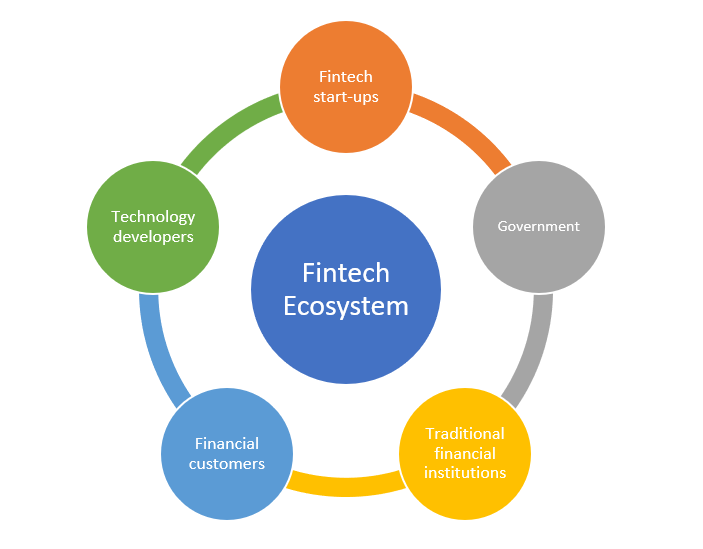The disruptive innovation that is the fintech revolution was primarily sparked by the move from cash to cashless economies, e-Commerce, e-trading services, cryptocurrencies and more recently, accelerated by COVID-19. Investor sentiment in the fintech sector is at its peak. Globally, fintech funding in 2020 is estimated to have reached $105 billion.[1] India saw $1.46 billion worth of fintech investments in the first half of 2020 itself, a 60% jump compared to $919 million for the same period in 2019.[2]
What is fintech? It refers to the use of technology for the provision of financial services. While digital payments are at its forefront, it also includes paperless lending, digital currencies, peer-to peer-lending, securities trading and insurance. While there is no uniform definition of fintech, the Financial Stability Board, the international body that promotes financial stability, defines fintech as “technologically enabled innovation in financial services that could result in new business models, applications, processes or products with an associated material effect on financial markets and institutions and the provision of financial services”.[3]
The following graphic outlines the stakeholders that define the fintech ecosystem:

Given its relevance across sectors and borders, primarily led by the potential of scale, it has attracted interest not only from the private equity and venture capital investor but also banks, Big Tech companies, public sector companies and governments across the world. India’s RuPay, indigenously created by the National Payments Corporation of India, holds 60% market share of the total cards issued in India[4] and 30% by value[5]. PayPal, a U.S. digital payments company, has a valuation of over $300 billion.[6] China’s Ant Financial, which owns Alipay, was valued at over $315 billion at the time of its prospective IPO in 2020.[7]
The Big Tech companies have the potential to become even bigger, as they can leverage Big Data to power their way through to the fintech pinnacle and attain market/sectoral leadership. Google, in addition to Google Pay, has already started developing physical and virtual debit cards, similar to the Apple Card. In fact, it also has its own investment arm, Google Ventures, which provides seed capital to tech start-ups including those into lending services, payment, banking and cryptocurrencies.
The future is likely to see ‘Big Fintech’ replace ‘Big Tech’. But this time around, India can be part of the story from the ground up. India has been ahead of the fintech game on the technology, regulatory and consumer fronts.
India is the first country to introduce a digital infrastructure tool called the ‘India Stack’. The cornerstone of the fintech revolution, India Stack is a set of application programming interfaces (APIs), that are publicly available thereby promoting open-source information for the provision of digital services. It has reaped massive and widespread benefits not only for the consumer and the government, but also industry, particularly telecom and banking, which have extensively leveraged the UPI and e-KYC APIs. Learning from the India Stack model, International Institute of Information Technology, Bangalore (IIIT-B), a world-renowned technology university, anchored the creation of MOSIP, an open-source digital identity platform.[8] Currently, MOSIP is being used by Morocco, Ethiopia, Sri Lanka and Philippines to develop their digital identity ecosystems.[9]
In the last few months, three homegrown fintech companies have achieved unicorn status – Cred, a credit card rewards and payments company; Groww, a personal finance start-up; and, Digit Insurance, an insurance tech start-up.[10] These add significant strength to the existing fintech unicorn club of Paytm, Pine Labs, PhonePe, RazorPay, Policy Bazaar and BillDesk, and reaffirm the faith of stakeholders in this sector. On the industry front, companies such as Piramal, Tech Mahindra and Wipro are showing increased interest too – the former is in talks to acquire Payments Technology Services, a fintech start-up, as it aims to establish its name in the banking and financial services.[11]
Technology and associated regulations in this sector that often target benefits to the under-served communities is one of the prime boosters of fintech growth in India. The creation of the RuPay and UPI system (built on the Immediate Payment Service or IMPS infrastructure), the real time payments system developed by the National Payments Corporation of India, is one example. UPI itself has seen over 200 crore monthly transactions since October 2020.[12] In fact the IMPS platform has been a huge success that has exploited blockchain technology. Countries such as UAE, Malaysia and Singapore have recognised this. India and Singapore entered into a formal MoU in 2018 to strengthen cooperation in financial innovation and India is implementing UPI-based QR Codes at airport terminals along with Singapore’s Network for Electronic Transfers.[13]
On regulation, the primary fintech regulator, the Reserve Bank of India (RBI), is leading from the front. As far back as July 2016, it created a Working Group on Fintech and Digital Banking to understand the sector and assess its implications on markets. More recently in January 2021, the RBI established a Working Group on Digital Lending.[14]
The RBI was one of the first in the world, along with Australia, U.K. and Singapore, to introduce regulatory sandboxes, a controlled testing environment, in 2019 in digital and contactless payment, and has already launched the second cohort of regulatory sandboxes in December 2020.[15] Government schemes and programs such as the Jan Dhan Yojana, Digital India and Start-up India have been major contributors too. Policies such as 100% FDI in the fintech sector has allowed foreign investments to flow in.
State level governance is not far behind. Maharashtra introduced its Fintech Policy 2018[16] which envisaged Mumbai to be a global fintech hub, provided for a corpus fund of Rs. 250 crores or $34 million, in addition to a separate fund for fintech accelerators/ incubators. Such progressive policies have the potential to make India a key stakeholder in the global fintech world.
Apart from India, Europe is moving ahead. The European Commission (EU), in 2015, revised the Payment Services Directive which promoted an integrated electronic payments market in the EU, competition and innovation, consumer protection, and provided greater transparency and protection of consumer data.[17] Japan and Australia have instituted similar regulatory frameworks.
Surprisingly, the U.S. is the slow runner on regulation and consumer adoption. The Federal Reserve Bank only now plans to introduce a real-time payment system, similar to the UPI, in 2023 called ‘FedNow’.[18]
What makes fintech so attractive?
- Sustainable technology: Blockchain (decentralised distributed ledger) which lies at the heart of fintech, provides a permanent record of data along with a high level of security, leading to transaction processing efficiency, reduced costs and transparency.
- Financial inclusion and access to capital: A classic example of India Stack’s enablement is that of RuPay, which targeted India’s masses, those who did not have access to financial capital. RuPay, which issues debit and credit cards, soon found success as it allowed every person to access payment cards due its affordability, and was highly accessible due to its linkage with Jan Dhan accounts. Mastercard too has introduced a fintech accelerator program – Fintech Express, aimed at financial inclusion in the MSME sector in Southeast Asia. China’s Union Pay was similarly launched to provide digital financial services to the lower income groups.
- Minimal technology development: Fintech players do not necessarily need to develop new technology, which can be both capital and time intensive. Players in the fintech market can leverage existing networks and technology such as that of telecom, open-source APIs and data networks. Companies can thus piggy-back on existing technology to provide financial services. In 2007, Kenya launched M-PESA mobile banking, a digital cash transfer service, which leveraged the existing telecom network to provide its services.
So, what is required to sustain the global fintech boom?
- Regulatory catalysts:
- At both the global and domestic level, it is necessary to have legislation on data protection and privacy, cybersecurity and AI, all of which are aligned towards creating a robust fintech ecosystem;
- Staggered compliance requirements: In order to balance innovation and regulation, policies should incorporate the varying compliance standards for companies subject to revenue-based thresholds. This will ensure that the MSMEs and smaller companies are not bogged down by excessive regulation and control.
- Virtual Fintech Parks: Taking from the concept of physical parks such as the SEZs in India, countries can locally introduce virtual fintech parks with the supporting digital tax and other fiscal incentives.
- Collaborations:
- Country-to-country: Sharing of best practices and capacity building measures: Mature fintech markets can assist under developed fintech markets by encouraging government-to-government as well as private sector partnerships such as that being done by India with MOSIP as well as India Stack. In addition, countries should share the challenges faced in adopting such best practices, and share insights from monitoring and evaluation activities on a regular basis. This will allow governments to be better prepared for effective policy and technology implementation at the domestic level.
- Domestic: Policy makers, regulators should hold regular discussions with the private sector and civil society members in order to foster innovation and address the challenges faced by industry.
There is no better time than now for fintech stakeholders to leverage the opportunities unleashed by the COVID-19 pandemic, from booming e-commerce to adoption of digital payments across demographics and geographies.
And, it is India’s IMPS and UPI models that can lead the global fintech order.
Ambika Khanna is Senior Researcher, International Law Studies Programme, Gateway House.
This article was exclusively written by Gateway House: Indian Council on Global Relations. You can read exclusive content here.
For interview requests with the author, please contact outreach@gatewayhouse.in.
© Copyright 2021 Gateway House: Indian Council on Global Relations. All rights reserved. Any unauthorized copying or reproduction is strictly prohibited.
References:
[1] https://home.kpmg/xx/en/home/media/press-releases/2021/02/vc-investment-in-fintech-more-than-doubles-in-second-half-of-2020.html
[2] https://www.investindia.gov.in/sector/bfsi-fintech-financial-services
[3] https://www.fsb.org/work-of-the-fsb/financial-innovation-and-structural-change/fintech/
[4] https://rbi.org.in/scripts/PublicationsView.aspx?Id=20315
[5] https://www.financialexpress.com/industry/banking-finance/rupays-market-share-by-volumes-is-34/2218027/
[6] https://www.marketwatch.com/story/paypal-valued-at-over-300-billion-for-the-first-time-11612463466
[7] https://www.reuters.com/article/us-china-ant-group-investors-exclusive-idUSKBN2B80JS
[8] https://www.mosip.io/about.php
[9] Kripalani. Manjeet, Gateway House, 29 April 2021. <https://www.gatewayhouse.in/making-digitalization-a-public-good/>
[10] https://ibsintelligence.com/3-indian-fintechs-that-reached-unicorn-valuation-in-2021/#:~:text=Groww%3A%20On%20April%207%20Bengaluru,Neeraj%20Singh%2C%20and%20Ishan%20Bansal
[11] http://bwdisrupt.businessworld.in/article/Tech-Mahindra-To-Acquire-Fintech-Startup-Payments-Technology-Services-For-9M-/13-01-2021-364923/
[12] https://rbi.org.in/scripts/PublicationsView.aspx?Id=20315
[13] https://www.nets.com.sg/newsroom/nets-ties-up-with-indias-national-payments-corporation-of-india-to-facilitate-cross-border-usage-and-acceptance/
[14] https://www.rbi.org.in/Scripts/BS_PressReleaseDisplay.aspx?prid=50961
[15] https://rbi.org.in/scripts/PublicationsView.aspx?Id=20315
[16] https://fintech.maharashtra.gov.in/documents/GR_FintechPolicy.pdf
[17] https://eur-lex.europa.eu/legal-content/EN/TXT/?uri=CELEX:32015L2366
[18] https://www.federalreserve.gov/paymentsystems/fednow_faq.htm


